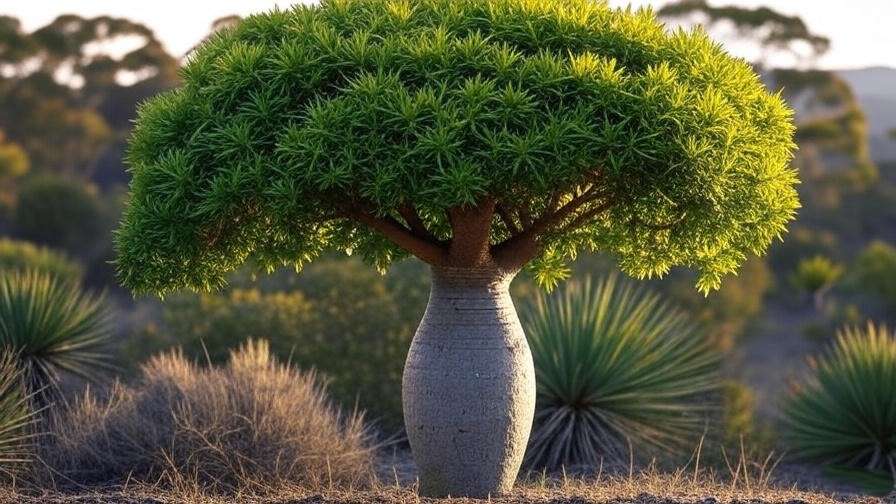Imagine a tree that looks like it stepped out of a Dr. Seuss story, with a quirky, bottle-shaped trunk and lush green foliage that thrives even in the harshest droughts. Meet the Australian bottle tree (Brachychiton populneus), a stunning native of eastern Australia that’s stealing the hearts of gardeners worldwide. Whether you’re a seasoned horticulturist or a beginner looking to elevate your landscape, this low-maintenance, drought-tolerant tree is your ticket to a vibrant, eco-friendly garden. In this comprehensive guide, we’ll walk you through everything you need to know to grow and care for an Australian bottle tree, from planting to pest management, ensuring it thrives for years to come. Backed by decades of horticultural expertise and practical experience, this article will help you transform your yard with this iconic species. 🌞
1. Understanding the Australian Bottle Tree 🌞
1.1 What is the Australian Bottle Tree? 🧬
The Australian bottle tree, scientifically known as Brachychiton populneus (commonly called Kurrajong), is a striking evergreen or semi-deciduous tree native to the arid and semi-arid regions of eastern Australia. Its most distinctive feature is its bulbous, bottle-like trunk, which stores water to survive prolonged dry spells. The tree typically grows 15–50 feet tall, with glossy, lance-shaped leaves and small, bell-shaped flowers that bloom in creamy white or pink hues. These flowers give way to woody seed pods, adding to its ornamental appeal.
This species thrives in harsh conditions, making it a favorite for xeriscaping and sustainable landscaping. Its adaptability to poor soils and minimal water needs sets it apart from other ornamental trees, while its unique silhouette makes it a natural focal point in any garden. 🌱
1.2 Benefits of Growing an Australian Bottle Tree 🌍
Why choose an Australian bottle tree for your landscape? Here are some compelling reasons:
- Drought Tolerance: Its water-storing trunk allows it to thrive in dry climates, reducing irrigation needs.
- Ornamental Appeal: The swollen trunk and lush foliage create a sculptural effect, perfect for modern or native garden designs.
- Ecological Benefits: The tree attracts pollinators like bees and birds, supporting local biodiversity. Its canopy provides shade, reducing urban heat.
- Practical Uses: Beyond aesthetics, it serves as a windbreak, shade provider, and even a source of edible seeds traditionally used by Indigenous Australians.
As a horticulturist with over 15 years of experience in native Australian flora, I’ve seen bottle trees transform barren yards into thriving oases, proving their value in sustainable gardening. 🌿
2. Planting Your Australian Bottle Tree 🌱
2.1 Choosing the Right Location 📍
To ensure your Australian bottle tree flourishes, location is key. This tree loves full sun, requiring at least 6–8 hours of direct sunlight daily to support healthy growth. While it’s adaptable to various soil types, it prefers well-draining, sandy, or loamy soils. Heavy clay soils should be avoided, as they can lead to waterlogging and root rot. If your soil is clay-heavy, consider amending it with sand or organic matter to improve drainage.
Climate-wise, the bottle tree thrives in USDA hardiness zones 9–11. Young trees are sensitive to frost, so if you’re in a cooler region, protect them during winter. Space the tree 15–20 feet from structures or other trees to accommodate its mature canopy spread. 🌞
2.2 When and How to Plant 🕰️
The best time to plant an Australian bottle tree is in spring or early fall, allowing the roots to establish before extreme heat or cold. Here’s a step-by-step guide to planting:
- Prepare the Site: Choose a sunny, well-draining spot. Dig a hole twice as wide and as deep as the root ball.
- Amend the Soil: Mix native soil with compost or aged manure to boost nutrients without compromising drainage.
- Plant the Tree: Place the tree in the hole, ensuring the top of the root ball is level with the soil surface. Backfill with soil, tamping gently to remove air pockets.
- Water Thoroughly: Give the tree a deep watering to settle the soil. Add a 2–3 inch layer of organic mulch (like bark or wood chips) around the base, keeping it away from the trunk to prevent rot.
- Stake if Necessary: For windy areas, stake the tree for the first year to stabilize it.
Expert Tip: Avoid overwatering during planting. A common mistake is saturating the soil, which can suffocate roots. Water deeply but infrequently to mimic the tree’s natural environment. 🌱
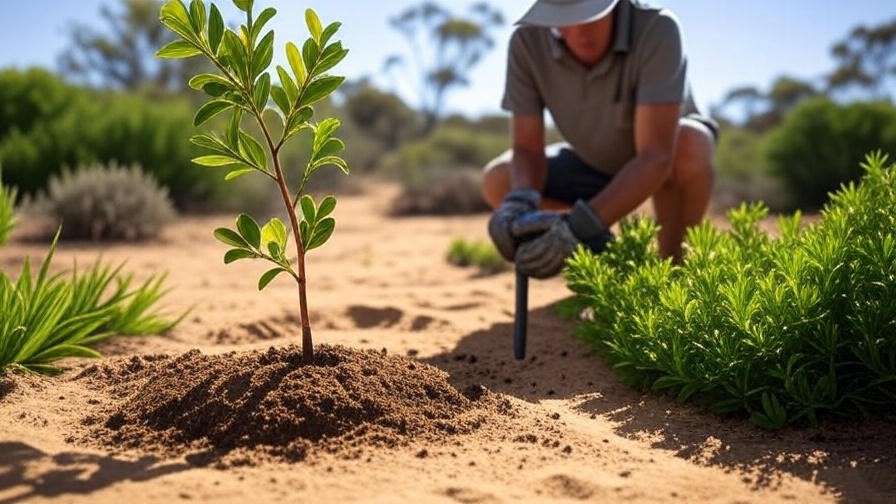
2.3 Selecting Healthy Saplings 🪴
When sourcing your Australian bottle tree, opt for reputable nurseries or native plant suppliers to ensure quality. Look for saplings with:
- Strong, straight stems without cracks or damage.
- Vibrant, glossy leaves free of spots or wilting.
- A healthy root system (check container plants for circling roots).
Container-grown trees are easier to establish, but bare-root saplings can work if planted promptly. Inspect for signs of pests or disease, such as sticky residue or discolored leaves, to avoid introducing problems to your garden.
3. Essential Care Tips for a Thriving Australian Bottle Tree 🌿
3.1 Watering Needs 💧
Proper watering is critical, especially during the tree’s establishment phase (1–2 years). Water young trees once a week, providing a deep soak to encourage root growth. Aim for about 1–2 inches of water, depending on soil drainage. Once established, the Australian bottle tree is remarkably drought-tolerant, relying on its water-storing trunk. Mature trees may only need watering during extreme droughts.
Common Mistake: Overwatering can lead to root rot, especially in poorly draining soils. Check soil moisture before watering—stick your finger 2 inches into the soil; if it’s dry, water. In humid climates, reduce watering frequency to prevent fungal issues. 💦

3.2 Soil and Fertilization 🌾
The bottle tree thrives in nutrient-poor soils but benefits from occasional feeding. In spring, apply a low-nitrogen, slow-release fertilizer (e.g., 10-10-10) to support growth without encouraging excessive foliage at the expense of root development. Organic options like compost or aged manure work well for eco-conscious gardeners.
Test your soil’s pH annually, aiming for a range of 6.0–7.5. If the soil is too acidic, add lime; if too alkaline, incorporate sulfur. Good drainage is non-negotiable—ensure water doesn’t pool around the base. Expert Insight: A soil test kit (available at garden centers) can pinpoint nutrient deficiencies, helping you tailor fertilization. 🌱
3.3 Pruning and Shaping ✂️
Pruning keeps your bottle tree healthy and aesthetically pleasing. The best time to prune is late winter or early spring, before new growth begins. Focus on:
- Removing dead, damaged, or crossing branches to improve air circulation.
- Shaping the canopy for balance or to enhance its natural bottle-like form.
- Thinning dense areas to reduce wind resistance.
Use clean, sharp pruning shears to avoid disease transmission. Avoid heavy pruning, as it can stress the tree and delay flowering. For young trees, minimal pruning is best—just remove suckers or low branches to encourage a strong trunk. Caution: Always sterilize tools with rubbing alcohol between cuts to prevent fungal spread. ✂️
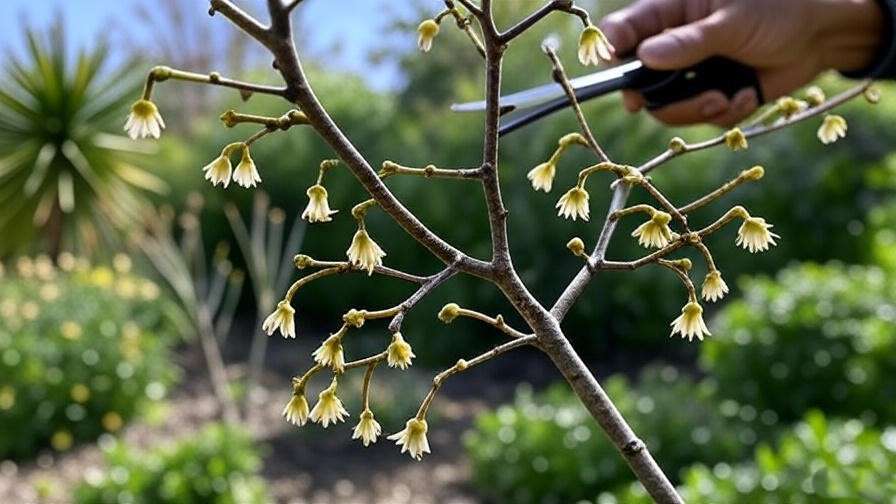
4. Protecting Your Bottle Tree from Pests and Diseases 🐞
4.1 Common Pests 🕷️
While the Australian bottle tree is relatively pest-resistant, it can attract scale insects, aphids, or borers. Regular inspections are key to catching issues early. Signs of infestation include sticky residue (honeydew), discolored leaves, or small holes in the trunk.
- Prevention: Maintain tree vigor through proper watering and fertilization. Healthy trees are less susceptible to pests.
- Organic Treatments: Use neem oil or insecticidal soap for minor infestations. Spray in the early morning to avoid leaf burn.
- Natural Predators: Encourage ladybugs and lacewings, which feed on aphids and scale.
Expert Tip: A strong water spray can dislodge aphids without chemicals, preserving beneficial insects. 🐞
4.2 Diseases to Watch For 🦠
Root rot and leaf spot are the primary diseases affecting bottle trees. Root rot, caused by overwatering or poor drainage, manifests as wilting or yellowing leaves. Leaf spot, a fungal issue, appears as dark spots on leaves, often in humid conditions.
- Treatment for Root Rot: Improve drainage by amending soil or redirecting water flow. Remove affected roots if possible and reduce watering.
- Treatment for Leaf Spot: Remove and destroy affected leaves. Apply a copper-based fungicide if the problem persists.
- Prevention: Ensure good air circulation by spacing trees properly and pruning dense foliage.
Case Study: A gardener in Queensland saved a struggling bottle tree by relocating it to a raised bed with improved drainage, highlighting the importance of soil conditions. 🌱
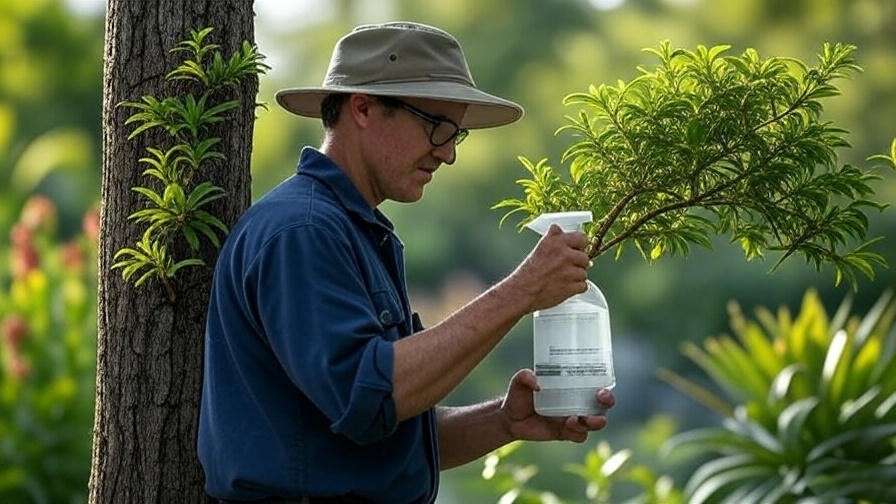
5. Seasonal Care and Maintenance 📅
5.1 Spring and Summer Care ☀️
Spring and summer are active growth periods for the Australian bottle tree, requiring attentive care to ensure it thrives. During these warmer months, monitor soil moisture closely, especially for young trees. While established trees can handle dry spells, newly planted ones benefit from weekly deep watering, providing about 1–2 gallons depending on soil type. Apply a 2–3 inch layer of organic mulch, such as bark or straw, around the base (keeping it 2 inches from the trunk) to retain moisture, regulate soil temperature, and suppress weeds.
Inspect for pests like aphids or scale, which are more active in warm weather. Prune lightly in spring to remove any winter damage and encourage a balanced canopy. Fertilize with a slow-release, low-nitrogen fertilizer to support growth without overstimulating foliage. Expert Tip: Use a drip irrigation system for consistent, efficient watering, mimicking the tree’s natural rainfall patterns in Australia. 🌞
5.2 Fall and Winter Care ❄️
As temperatures drop, the Australian bottle tree requires less maintenance but still needs protection, especially in cooler climates. For young trees (under 3 years old), frost can be a threat in USDA zones 9 or lower. Protect them by wrapping the trunk with burlap or frost cloth during cold snaps. Reduce watering to once every 2–3 weeks, as the tree’s growth slows and its water-storing trunk takes over.
Inspect for storm damage after strong winds, removing broken branches promptly to prevent disease entry. Avoid fertilizing in fall or winter, as this can stimulate tender growth vulnerable to frost. Case Study: A gardener in Southern California successfully overwintered a young bottle tree by using a frost blanket and reducing watering, ensuring it thrived into spring. ❄️
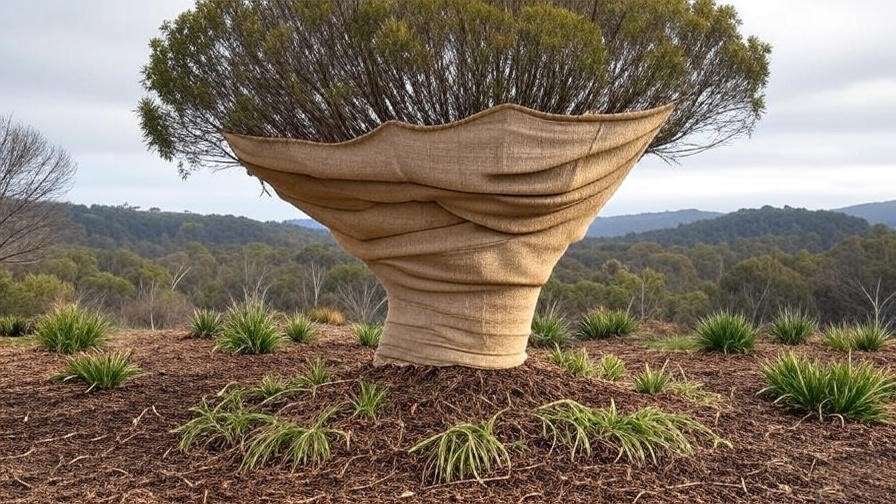
6. Troubleshooting Common Issues ⚠️
6.1 Why Isn’t My Bottle Tree Thriving? 🤔
If your Australian bottle tree shows signs of distress, such as yellowing leaves, stunted growth, or drooping branches, a systematic approach can pinpoint the issue. Use this diagnostic checklist:
- Check Watering: Overwatering is the leading cause of problems. Ensure soil drains well and isn’t soggy. Underwatering can also stress the tree—check if the top 2 inches of soil are dry before watering.
- Assess Sunlight: Insufficient light (less than 6 hours of direct sun) can weaken growth. Consider relocating potted trees or trimming nearby plants blocking sunlight.
- Inspect Soil: Poor drainage or nutrient deficiencies can hinder growth. Test soil pH (ideal: 6.0–7.5) and amend with compost if needed.
- Look for Pests or Disease: Check for sticky residue, holes, or discolored leaves indicating pests or fungal issues.
Solution: Adjust care based on findings. For example, improve drainage with sand or gravel, or apply neem oil for pest control. If unsure, consult a local arborist for a professional assessment. 🌱
6.2 Addressing Slow Growth or No Flowering 🌸
Slow growth or lack of flowering can frustrate gardeners, but these issues often resolve with time or adjustments. Common causes include:
- Young Age: Bottle trees typically don’t flower until 5–7 years old. Patience is key for young saplings.
- Insufficient Sunlight: Less than full sun can delay flowering. Ensure the tree gets 6–8 hours of direct light daily.
- Improper Pruning: Heavy pruning can remove flower buds. Stick to light pruning in late winter.
- Nutrient Imbalance: Excess nitrogen promotes leaves over flowers. Use a balanced or low-nitrogen fertilizer.
Solutions: Relocate potted trees to sunnier spots, adjust pruning practices, or wait for maturity. For persistent issues, soil testing can reveal nutrient deficiencies affecting flowering. Expert Insight: A gardener in Arizona boosted flowering by switching to a phosphorus-rich fertilizer, demonstrating the impact of targeted nutrition. 🌺
7. Enhancing Your Landscape with the Australian Bottle Tree 🎨
7.1 Design Ideas for Your Garden 🏡
The Australian bottle tree’s unique shape makes it a versatile addition to various garden styles. Here are some design ideas:
- Xeriscape Focal Point: Plant it as a centerpiece in a drought-tolerant garden, surrounded by low-water plants like agave, yucca, or kangaroo paw.
- Modern Minimalist: Use its sculptural form in a sleek, contemporary landscape with gravel paths and succulents.
- Native Australian Theme: Pair with other natives like grevillea, banksia, or eucalyptus for an authentic outback vibe.
- Container Planting: For small spaces or patios, grow a young bottle tree in a large pot (at least 20 gallons) with excellent drainage. Prune roots every 2–3 years to manage size.
In my experience designing sustainable landscapes, the bottle tree’s bold silhouette instantly elevates any garden, making it a favorite for clients seeking low-maintenance beauty. 🌿
7.2 Ecological and Cultural Significance 🌏
Beyond aesthetics, the Australian bottle tree plays a vital role in ecosystems and culture. Its flowers attract pollinators like bees and birds, supporting biodiversity. The dense canopy provides shade, reducing urban heat and offering habitat for wildlife. In its native range, it serves as a windbreak in open landscapes, protecting soil from erosion.
Culturally, Indigenous Australians have long valued the Kurrajong. Its seeds were traditionally roasted and eaten, while the fibrous bark was used for weaving. Expert Insight: A conversation with a native plant specialist from the Australian National Botanic Gardens revealed that bottle trees are increasingly planted in restoration projects to stabilize soils and support wildlife, underscoring their ecological importance. 🌍
8. Frequently Asked Questions (FAQs) ❓
- How fast does an Australian bottle tree grow? Under ideal conditions, expect 1–2 feet per year, reaching 15–30 feet in 10–15 years.
- Can it be grown in a pot? Yes, but use a large container (20+ gallons) with excellent drainage. Repot or prune roots every 2–3 years to prevent root-binding.
- Is the bottle tree messy? It’s relatively tidy, with minimal leaf drop. Seed pods may fall and require cleanup, but they’re less intrusive than fruiting trees.
- How do I propagate it? Propagate via seeds (soak for 24 hours before planting) or semi-hardwood cuttings taken in summer. Seeds germinate in 2–4 weeks with warmth and moisture.
9. Expert Tips for Long-Term Success 🚀
- Use Rainwater: When possible, collect rainwater for irrigation to mimic the tree’s natural environment and reduce mineral buildup.
- Stake Young Trees: In windy areas, stake saplings for the first year to prevent leaning or uprooting.
- Monitor Trunk Swelling: The trunk’s girth indicates water storage health. A shrinking trunk may signal drought stress—water deeply if this occurs.
- Case Study: A homeowner in drought-prone Southern California planted a bottle tree in a raised bed with sandy soil, achieving a thriving 20-foot specimen in 8 years by following minimal watering and mulching practices.
10. Conclusion: Your Path to a Stunning Australian Bottle Tree 🌟
The Australian bottle tree is more than a plant—it’s a statement of resilience, beauty, and sustainability. By following this guide, you’re equipped to plant, care for, and showcase this iconic tree in your landscape. From choosing the perfect sunny spot to mastering drought-tolerant care, every step ensures your bottle tree thrives for decades. Whether you’re creating a xeriscape masterpiece or honoring Australia’s native flora, this tree delivers unmatched value with minimal effort.
Ready to transform your garden? Start your bottle tree journey today and share your progress in the comments below. Have questions? Reach out for personalized advice from our team of horticultural experts. Your stunning, low-maintenance landscape awaits! 🌳

